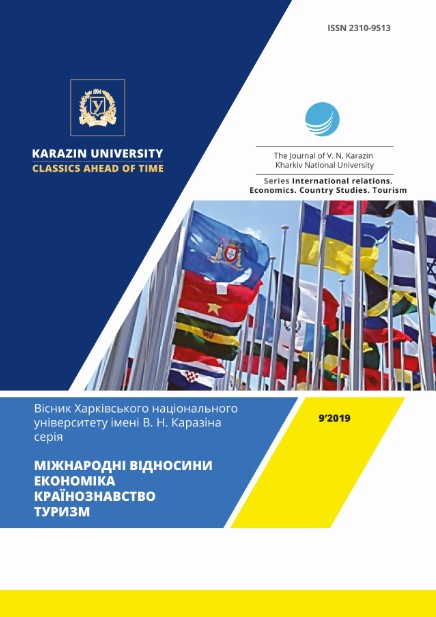The impact of global institutionalization within the wto on foreign trade flows, the case of Ukraine
Abstract
Since the establishment of the World Trade Organization (WTO) as the main institutionalizing force in the trade area more than 20 years ago, developing countries have sought to gain special recognition and treatment within the multilateral system in order to solve their structural and systemic problems.However, the impact of global institutionalization within the WTO on member-countries’ foreign trade remains debatable. The subject of research of the article is the impact of global institutionalization within the WTO on Ukraine’s foreign trade flows. The objective is to evaluate the impact the global institutionalization within the WTO has on the foreign trade of Ukraine and develop a roadmap for national institutional environment improvement. The main method used is gravity modelling.Heritage Foundation’s Index of Economic Freedom, World Economic Forum’s Index of Global Competitiveness and World Bank’s world gavernance indicators are used separately in constructed models as institutional variables. All the models also include dummy variables, which indicate WTO – or RTA-membership of two countries. The sample includes all the countries, which have been trade partners of Ukraine during last 20 years. The following results were obtained:6 gravity models areconstructed, which allowes to calculate the possible percentage of Ukraine’s exports increase due to the enhancement of Ukraine’s institutional variables to theaverage European level and develop a roadmap for national institutional framework improvement. Conclusions: the calculated percentage of increase proves that the global institutionalization within the WTO may have a a positive impact on Ukraine’s foreign trade flows, gravitaty modelling helps in determining how Ukraine’s national institutional framework can be improved.
Downloads
References
Acemoglu, D., Johnson, S., & Robinson, J. A. (2005). Institutions as a fundamental cause of long-run growth. Handbook of economic growth, 1, 385-472.
Anderson, J. E. (2008). Trade and informal institutions. Handbook of International Trade. Blackwell Publishing, Oxford, 279-293.
Berenda, S., Shkonda, S. (2018). The role of WTO Dispute Settlement System in international and national institutional framework: the case of Ukraine. International Journal of Economics, Commerce & Management, 1 (6), 78-98.
Babetskaia-Kukharchuk, O., & Maurel, M. (2003). Accession to the WTO and EU enlargement: what potential for trade increase? CERP Discussion Paper, 3944.
Babetskaia-Kukharchuk, O. A. (2005). On measurement of institutions in trade, growth, and investment studies. Экономический журнал Высшей школы экономики, 9(4).
Drautzburg, T., Melnykovska, I., & Schweickert, R. (2008). Which membership matters? External vs. internal determinants of institutional change in transition countries. Kiel Working Paper, 1421.
Greif, A. (1992). Institutions and international trade: Lessons from the commercial revolution. The American Economic Review, 82(2), 128-133.
Hall, R. E., & Jones, C. I. (1999). Why do some countries produce so much more output per worker than others? The quarterly journal of economics, 114(1), 83-116.
Li, D., & Wu, C. (2004). WTO and Growth: A Cross Country Event Study.
Matthews, R. C. (1986). The economics of institutions and the sources of growth. The Economic Journal, 96(384), 903-918.
North, D. (1990). Institutional Chande and Economic Performance.
Olson, M. (1996). Distinguished lecture on economics in government: big bills left on the sidewalk: why some nations are rich, and others poor. Journal of economic perspectives, 10(2), 3-24.
Persson, M. and Wilhelmsson, F. (2007), Assessing the Effects of EU Trade Preferences for Developing Countries. Bourdet, Y., Gullstrand, J., & Olofsdotter, K. (Eds.). The European Union and Developing Countries: Trade, Aid, and Growth in an Integrated World, Edward Elgar.
Piazolo, D. (1999). Growth effects of institutional change and European integration.
Rodrik, D., Subramanian, A., & Trebbi, F. (2004). Institutions rule: the primacy of institutions over geography and integration in economic development. Journal of economic growth, 9(2), 131-165.
Rose, A., & van Wincoop, E. (2001). National Money as a Barrier to Trade: The Real Case for Monetary Union". American Economic Review, Vol. 91, issue 2, 386-390.
Subramanian, A., & Wei, S. J. (2007). The WTO promotes trade, strongly but unevenly. Journal of international Economics, 72(1), 151-175.
Veblen, T. (2017). The theory of the leisure class. Routledge.
The Heritage Foundation. (2017). Index of Economic Freedom. Retrieved from https://www.heritage.org/index/pdf/2017/regions/2017_IndexOfEconomicFreedom_EUROPE.pdf
World Economic Forum (2018). The Global Competitiveness Report 2017-2018. Retrieved from http://www3.weforum.org/docs/GCR2017-2018/05FullReport/TheGlobalCompetitivenessReport2017%E2%80%932018.pdf
World Trade Organization. (2018). World Trade Organization. Retrieved from http://wto.org
World Bank Group. (2018). World Bank Group. Retrieved from http://worldbank.org/
Authors who publish with this journal agree to the following terms:
- Authors retain copyright and grant the journal right of first publication of this work under the terms of a license Creative Commons Attribution License 4.0 International (CC BY 4.0).
- Authors are able to enter into separate, additional contractual arrangements for the non-exclusive distribution of the journal's published version of the work (e.g., post it to an institutional repository or publish it in a book), with an acknowledgement of its initial publication in this journal.
- Authors are permitted and encouraged to post their work online (e.g., in institutional repositories or on their website) prior to and during the submission process, as it can lead to productive exchanges, as well as earlier and greater citation of published work.




